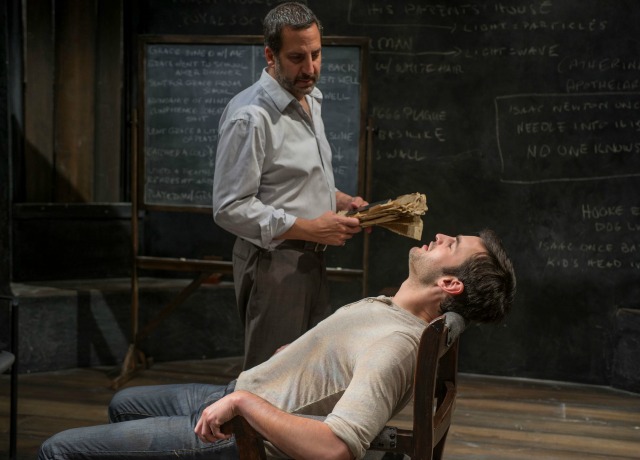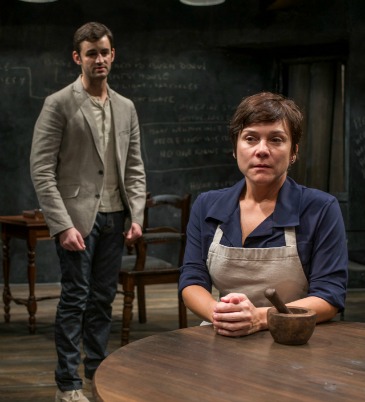'Isaac's Eye' Blurs Historical Truth And Fiction
By Melody Udell in Arts & Entertainment on Sep 19, 2014 3:00PM

'Isaac's Eye' at Writers Theatre.
In Writers Theatre’s production of Isaac’s Eye, playwright Lucas Hnath reimagines famed British scientist Isaac Newton (Jurgen Hooper) and his now lesser-known academic rival, Robert Hooke (Marc Grapey) with a partly fictional, partly historical lens. The actors, breaking any pretense of a fourth wall, help the audience understand the truthful elements of the play by writing all of the historical facts on a chalkboard backdrop. But this unusual, albeit intriguing, literary device seems to warrant more time documenting the truth than telling a cohesive story, fictional or otherwise.
Among the various chalkboard facts with which Hnath constructs his premise: at age 19, Newton threatened to burn down his parents’ house. His hair turned white in his early 20s. And most shocking of all, he did, in fact, try to prove that light is made up of particles by sticking a needle in his own tear duct. Also a fact: Hooke, who had been serving as the director of experiments at the prestigious Royal Society when Newton was just 25 years old and desperate to join their ranks, made several breakthroughs in the scientific community, including discovering the law of elasticity early theories on combustion. But it’s the fictional elements, including an unsatisfying love triangle between the two rival scientists and an apothecary named Catherine Storer (Elizabeth Ledo), that leads Hnath’s play through an a linear jumble of themes and manufactured tension.
The three actors, joined by a fourth, LaShawn Banks, who serves as the show’s narrator, speak in contemporary language and don’t even bother with British accents. Their costumes, confusingly, seem to reflect modern day apparel with a nod to 17th century England: Hooke in a trench coat, Newton in a presumably H&M T-shirt, and a stockings-clad Catherine in a drab sheath dress and apron. Isaac’s Eye doesn’t seem concerned with consistency. But such is Hynath’s style—an ultra-hip, “what-if” tone that doesn’t yearn to be taken too seriously. Even Newton himself gives off a little oddball humor, emitting a wavering little “yay” after things go his way.

Elizabeth Ledo and Jurgen Hooper in 'Isaac's Eye.'
That little admission didn’t make it to the chalkboard. Neither did the blackmail. In fact, Hooke and Newton didn’t actually encounter each other until much later, when both of them had already been established into the Royal Society. To feed the dramatic narrative, though, Hnath chose to speed up their meeting and subsequent rivalry for the sake of a compelling storyline.
Ultimately, Isaac’s Eye’s is a quirky, 70-minute stage experiment to help the audience see history a little bit differently—even if that vision comes off a little blurry.
The show runs through Sunday, Dec. 7 at Writers Theatre at Books on Vernon, 664 Vernon Ave., Glencoe, 847-242-6000 or online.